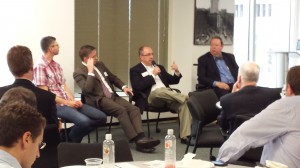By Eric Viola, WCTA Public Policy Analyst
June 9, 2014 (Seattle, WA) – Daniel Malarkey of 1Energy Systems opened the third event in the WCTA’s Climate Series, introducing the three panelists, Yoram Bauman, Todd Myers, and James Tansey before deferring to Jon Talton, the event’s moderator.

Jon Talton, Seattle Times economics columnist, opened the discussion by saying that there is “a cost associated with carbon emissions that isn’t reflected in pricing,” and that, to move emissions to a more efficient level, the State has several options. One of those options is a carbon tax.
“If we can make polluting expensive, we can reduce carbon emissions through market forces,” panelist Yoram Bauman explained. Bauman, the world’s first self-proclaimed stand-up economist, described the two main paths chosen by governments seeking to reduce carbon emissions. On the one hand, governments can impose strict regulation, such as setting individual emissions caps on specific companies. This path, command and control, is expensive to administer. The other path, using market-based instruments, takes advantage of existing market structures, resulting in a less expensive, more efficient model. One of the key features of a carbon tax espoused by Bauman is that it is “more transparent, more open, it’s a lot more clear what’s going on” than even other market-based instruments like cap-and-trade.
True to his title of ‘stand-up economist,’ Bauman presented the audience and his fellow panelists with a pithy haiku he wrote to describe his carbon pricing preference:
Carbon dioxide
Thirty dollars for each ton
Revenue neutral
“Cap and trade,” Bauman continued, “is more like War and Peace” in terms of complexity.
Todd Myers, Director of the Washington Policy Center’s Center for the Environment, continued Bauman’s discussion of the differences between cap-and-trade and a carbon tax. “Cap and trade has very large price swings,” Myers said, “and in Washington, prices would be extra volatile due to energy reliance on snow melt.”
Myers went on to address the State’s options when it came to what to do with revenue garnered from a carbon tax. “Revenue neutral means we can move taxes around, we don’t need to add a new tax,” he explained. As far as political feasibility goes, it’s much easier to move tax burden than it is to create a new tax altogether.
“It’s not a new tax, it’s a tax shift,” echoed James Tansey, Executive Director of ISIS at the University of British Columbia. On the other hand, he explained, “it’s very easy to remove.” Without the vast and complicated structure surrounding cap-and-trade—a system that would entrench itself so thoroughly, Bauman likened it to Guantanamo Bay—policy reversal is much more likely.
“The tradeoff between a carbon tax and cap and trade has been exaggerated,” asserted Tansey, “both are the cheapest ways to reduce carbon emissions.” Providing incentives for energy alternatives, like wind or solar, is between four and five times more expensive, and results in an uneven landscape of support for alternatives. The cost of a command and control approach to carbon emissions is similarly astronomical compared to the lean efficiency of cap and trade or a simple carbon tax.
As the panel wrapped up the event, Talton opened the floor to questions from the audience. The panel answered questions about British Columbia’s successful carbon tax, the issue of imported goods with high associated emissions, and the State’s transportation system.
“There is risk with climate change, but we have to get it right; you don’t want to spend a dollar to save a dime,” Myers closed, touching again on the State’s responsibility to address market failure while being fiscally responsible.
The WCTA’s Climate Series concludes with its fourth installment, an in-depth review of cap-and-trade systems, on Monday, June 30th.
To view a full recording of the event, visit TVW here.